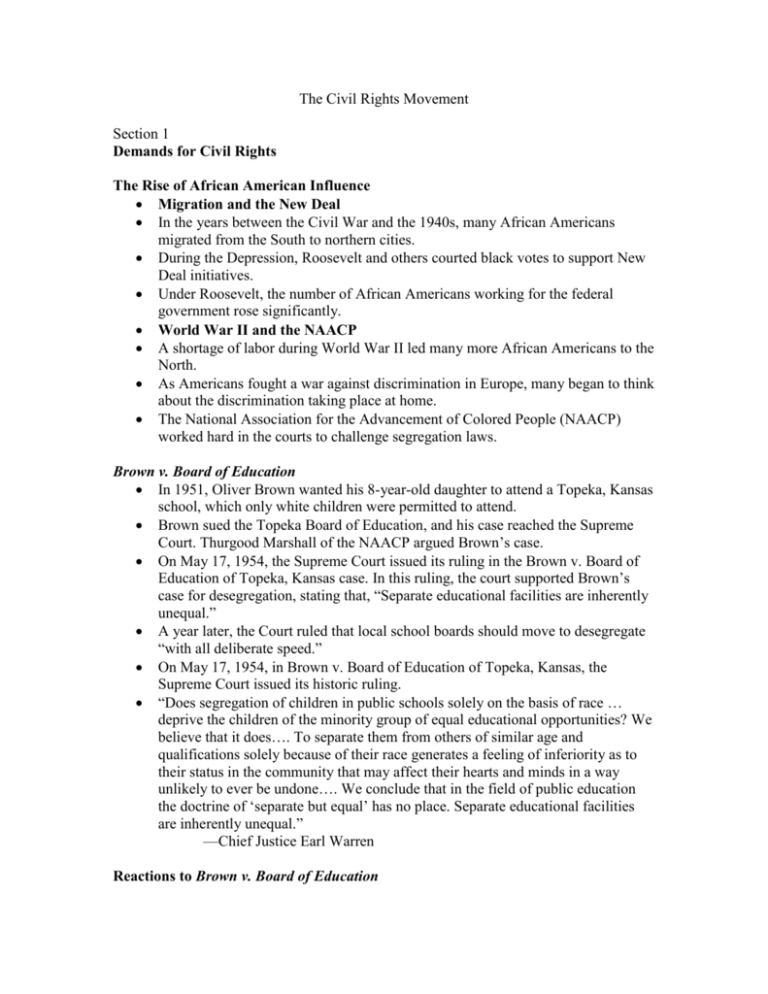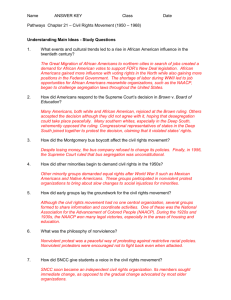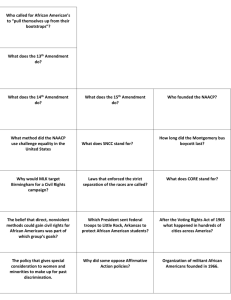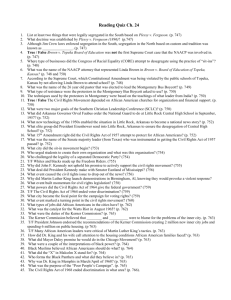The Civil Rights Movement
advertisement

The Civil Rights Movement Section 1 Demands for Civil Rights The Rise of African American Influence Migration and the New Deal In the years between the Civil War and the 1940s, many African Americans migrated from the South to northern cities. During the Depression, Roosevelt and others courted black votes to support New Deal initiatives. Under Roosevelt, the number of African Americans working for the federal government rose significantly. World War II and the NAACP A shortage of labor during World War II led many more African Americans to the North. As Americans fought a war against discrimination in Europe, many began to think about the discrimination taking place at home. The National Association for the Advancement of Colored People (NAACP) worked hard in the courts to challenge segregation laws. Brown v. Board of Education In 1951, Oliver Brown wanted his 8-year-old daughter to attend a Topeka, Kansas school, which only white children were permitted to attend. Brown sued the Topeka Board of Education, and his case reached the Supreme Court. Thurgood Marshall of the NAACP argued Brown’s case. On May 17, 1954, the Supreme Court issued its ruling in the Brown v. Board of Education of Topeka, Kansas case. In this ruling, the court supported Brown’s case for desegregation, stating that, “Separate educational facilities are inherently unequal.” A year later, the Court ruled that local school boards should move to desegregate “with all deliberate speed.” On May 17, 1954, in Brown v. Board of Education of Topeka, Kansas, the Supreme Court issued its historic ruling. “Does segregation of children in public schools solely on the basis of race … deprive the children of the minority group of equal educational opportunities? We believe that it does…. To separate them from others of similar age and qualifications solely because of their race generates a feeling of inferiority as to their status in the community that may affect their hearts and minds in a way unlikely to ever be undone…. We conclude that in the field of public education the doctrine of ‘separate but equal’ has no place. Separate educational facilities are inherently unequal.” —Chief Justice Earl Warren Reactions to Brown v. Board of Education Many Americans, both white and African American, rejoiced at the Brown ruling. Others accepted the decision although they did not agree with it, hoping that desegregation could take place peacefully. Many southern whites, especially in the Deep South, vehemently opposed the ruling. Congressional representatives of states in the Deep South joined together to protest the decision, claiming that it violated states’ rights. The Montgomery Bus Boycott The Montgomery Bus Boycott Background of the Boycott —In December 1955, an African American seamstress named Rosa Parks was seized by the police in Montgomery, Alabama when she refused to give up her seat on a bus to a white man. Organization of the Boycott —In response, civil rights leaders, including Martin Luther King, Jr., organized a boycott of the Montgomery bus system. The Bus Boycott —Over the next year, 50,000 African Americans boycotted the city bus system, choosing to walk, ride bicycles, or carpool instead. Results of the Bus Boycott — Despite losing money, the bus company refused to change its policies. Finally, in 1956, the Supreme Court ruled that bus segregation was unconstitutional. Resistance in Little Rock Opposition to Integration In the fall of 1957, Arkansas Governor Orval Faubus felt that enforcing integration, or the bringing together of different races, would create chaos. Faubus therefore posted Arkansas National Guard troops at Central High School in Little Rock, instructing them to turn away the nine African American students who were supposed to attend that school. Mobs of angry protesters joined the National Guard in intimidating the African American students. Government Response Faubus’s actions defied the Brown decision. President Eisenhower viewed these actions as a challenge to the Constitution and to his authority as President. Eisenhower placed the National Guard under federal command and sent soldiers to Arkansas to protect the nine students. Other Voices of Protest Like African Americans, other minority groups demanded equal rights after World War II. Mexican Americans found that peaceful protest could slowly bring about some of their goals. Groups such as the Community Service Organization and the Asociación Nacional México-Americana worked toward these goals. Native Americans faced problems of poverty, discrimination, and little real political representation. The 1953 government policy of termination, or elimination of reservations, met with resistance and was eventually discarded. Section 2 Leaders and Strategies Laying the Groundwork: The NAACP The NAACP was founded in 1909 as an interracial organization, one with both African American and white American members. W.E.B. Du Bois, a founding member, helped define the NAACP’s goals. During the 1920s and 1930s, the NAACP won many legal victories, especially in the areas of housing and education. Despite these victories, the NAACP received criticism from poorer African Americans, who claimed that it was out of touch with the issues of basic economic survival Other Civil Rights Organizations The National Urban League Founded in 1911, the National Urban League helped African Americans who were moving to northern cities. The League helped African Americans find homes and jobs in the cities, and insisted that employers help them learn skills which could lead to better jobs. The Congress of Racial Equality In 1942, the Congress of Racial Equality (CORE) was founded to help bring about change peacefully. Like the NAACP, CORE was an interracial organization which argued against discrimination and segregation. CORE came to have a major role in civil rights confrontations of the 1950s and 1960s. Philosophy of Nonviolence Rising civil rights leaders such as Martin Luther King, Jr., encouraged a philosophy of nonviolence among civil rights activists. In 1957, King and other African American clergymen founded the Southern Christian Leadership Conference (SCLC). SCLC would become a significant civil rights organization in the years ahead. SCLC advocated nonviolent protest, a peaceful way of protesting against restrictive racial policies. Nonviolent protesters were encouraged not to fight back even when attacked. The formation of SCLC shifted the focus of the civil rights movement to the South and brought African American church leaders such as King to its forefront. Dr. King Leads the Way King’s Influences Martin Luther King, Jr., was influenced by the beliefs and work of Mohandas Gandhi and Henry David Thoreau, both of whom advocated nonviolence. Gandhi had helped India gain its independence in 1947. Thoreau had advocated civil disobedience in the mid-1800s. King’s Actions After the Montgomery bus boycott, King began training volunteers for what they might expect in the months ahead. Those who rode the newly integrated buses were encouraged to follow the principles of nonviolence. King became a prominent figure in almost every major civil rights event, winning the Nobel peace prize in 1964 for his work. A New Voice for Students A new civil rights group run by young activists, the Student Nonviolent Coordinating Committee (SNCC), began in 1960 at a meeting in Raleigh, North Carolina. SNCC soon became an independent civil rights organization. Its members sought immediate change, as opposed to the gradual change advocated by most older organizations. One of SNCC’s most influential leaders was Robert Moses, a Harvard graduate student and mathematics teacher. Moses led with a quiet, humble style which earned him the admiration of his followers. Section 3 The Struggle Intensifies Sit-ins Challenge Segregation CORE created the sit-in in 1943 as a tactic to desegregate the Jack Spratt Coffee House in Chicago. The sit-in became a common, and powerful, tactic of the civil rights movement. During a sit-in, protesters sat down in a segregated public place, such as a lunch counter, refusing to leave until they were served. Sit-ins brought strong reactions in some places. People opposed to desegregation would sometimes mock, beat, or pour food on the protesters. Many sit-in participants were arrested and sent to jail. The Freedom Rides The Purpose of the Freedom Rides The 1960 Supreme Court case Boynton v. Virginia expanded the earlier ban on bus segregation to include bus stations and restaurants that served interstate travelers. In 1961, CORE and SNCC organized the Freedom Rides to test southern compliance with this ruling. Violence Greets the Riders Although the freedom riders expected confrontation, the violence which greeted a bus in Anniston, Alabama, was more than they had anticipated. A heavily armed white mob disabled the bus and then set it on fire. As riders escaped from the bus, they were beaten by the mob. Reactions to the Freedom Rides Americans were horrified by the violence which had greeted the bus in Anniston. Despite the potential danger involved, Freedom Rides continued during the summer. Many riders were arrested. Attorney General Robert Kennedy had originally been opposed to lending federal support to the Freedom Rides. However, he later sent federal marshals to protect the riders. Kennedy also pressured the Interstate Commerce Commission to prohibit segregation in all interstate transportation. The Justice Department began to sue communities that did not comply. Integration at “Ole Miss” In 1961, James Meredith, an African American student at Jackson State College, applied for admission to the all-white University of Mississippi, known as “Ole Miss.” When Meredith was rejected, he sought help from the NAACP. The NAACP argued that Meredith’s application had been rejected on racial grounds. When the case reached the Supreme Court, Meredith’s claim was upheld. Meredith continued to face problems as he enrolled at Ole Miss. Mississippi Governor Ross Barnett personally blocked Meredith’s way to the admissions office, and violence erupted on campus. The situation became a standoff between the governor and the Justice Department. President Kennedy sent federal marshals to escort Meredith around campus. Clash in Birmingham Marches in Birmingham In April 1963, Martin Luther King joined the Reverend Fred Shuttlesworth in a civil rights campaign in Birmingham, Alabama. City officials ordered civil rights protesters to end the march that was part of this campaign. When they did not, King and others were arrested. While in Birmingham Jail, King wrote a famous letter defending his tactics and his timing. Response to the Marches King was released more than a week later and continued the campaign, making the difficult decision to allow young people to participate. Police attacked the marchers with high-pressure fire hoses, police dogs, and clubs. As television cameras captured the violence, Americans around the country were horrified. Section 4 The Political Response Kennedy on Civil Rights During the 1960 presidential campaign, Kennedy won the support of many African American voters. Kennedy had voted for civil rights measures in the Senate but had not actively supported them. As President, he moved slowly on civil rights issues, not wanting to anger southern Democrats. Hours after Kennedy had given a speech against discrimination, civil rights leader Medgar Evers was murdered. This murder made it clear that government action was needed. After violence erupted in Birmingham in 1963, Kennedy introduced a stronger civil rights bill than he had originally planned. This bill called for an end to segregation in public places and in situations where federal funding was involved. The March on Washington To focus national attention on Kennedy’s bill, civil rights leaders proposed a march in Washington, D.C. The March on Washington was held in August 1963. More than 200,000 people came to the peaceful and orderly march, including musicians, religious leaders, and celebrities. At the march, Martin Luther King, Jr., delivered what was to become his best known speech, “I Have a Dream.” Despite the success of the march, Kennedy’s civil rights bill remained stalled in Congress. The Civil Rights Act of 1964 Johnson’s Role After Kennedy was assassinated, President Johnson worked to build support for Kennedy’s civil rights bill. The house passed the bill, but civil rights opponents in the Senate stalled it with a filibuster. This technique involved preventing a vote on a measure by taking the floor and refusing to stop talking. The Act Is Passed Johnson countered the filibuster with a procedure called cloture, a three-fifths vote to limit debate and call for a vote. In June 1964, the Senate voted for cloture. Soon afterwards, the bill passed, becoming the Civil Rights Act of 1964. Provisions of the Civil Rights Act Some Provisions of the Civil Rights Act of 1964 Title I — Banned the use of different voter registration standards for blacks and whites Title II — Prohibited discrimination in public accommodations such as restaurants, hotels, and theaters Title VI — Allowed the withholding of federal funds from programs that practice discrimination Title VII — Banned discrimination on the basis of race, sex, religion, or national origin by employers and unions and created the Equal Employment Opportunity Commission (EEOC) Fighting for the Vote Freedom Summer In 1964, leaders of the major civil rights groups organized a voter registration drive in Mississippi. About 1,000 African American and white volunteers participated in what came to be called Freedom Summer. Violence plagued Freedom Summer as volunteers were beaten, shot at, arrested, and murdered. African American churches and homes were burned and firebombed. The Democratic Convention Members of SNCC along with newly registered Mississippi voters organized the Mississippi Freedom Democratic Party (MFDP). The MFDP sent delegates to the 1964 Democratic national convention, insisting that they were the rightful representatives from Mississippi. President Johnson offered the MFDP two of Mississippi’s 68 seats. The MFDP rejected the offer, believing that it fell short of their goals. The Selma March and Legal Landmarks The Selma March To call attention to the issue of voting rights, King and other leaders decided to organize marchers to walk from Selma, Alabama, to Montgomery, about 50 miles away. Violence erupted at the start of the march. President Johnson sent military assistance to protect the marchers. When the march resumed, more people joined it, making a total of about 25,000 marchers. Legal Landmarks The Voting Rights Act of 1965 allowed federal officials to register voters in places where local officials were preventing African Americans from registering. It also effectively eliminated literacy tests and other barriers to voting. The Twenty-fourth Amendment to the Constitution, ratified in 1964, outlawed the poll tax, which was still in effect in several southern states. Section 5 The Movement Takes a New Turn Malcolm X and Black Nationalism Radical and militant political leaders emerged outside the mainstream civil rights movement. One of these leaders was Malcolm X. Born Malcolm Little, Malcolm X joined the Nation of Islam, also called the Black Muslims, which preached black separatism and self-help. As a minister of the Nation of Islam, Malcolm X spread the ideas of black nationalism, a belief in the separate identity and racial unity of the African American community. In 1964, Malcolm X made a pilgrimage to Mecca, Saudi Arabia, the holy city of Islam. Seeing Muslims of all races praying together changed his views on separatism, but he had only nine months to spread his new beliefs. In February 1965, he was shot to death. The Black Power Movement SNCC Shifts Gears SNCC became more radical under the leadership of Stokely Carmichael. Carmichael advocated ideas of black power, which called upon African Americans to embrace their heritage, build communities, and lead their own organizations. Black power fostered racial pride but also led to a major split in the civil rights movement. The Black Panthers In the fall of 1966, a new militant political party called the Black Panthers was formed. The Black Panthers wanted African Americans to lead their own communities. They also demanded that the federal government rebuild the nation’s ghettos. Because the Black Panthers monitored police activity in the ghettos, they often found themselves in violent encounters with police. Riots in the Streets The early civil rights movement had focused on de jure segregation, racial separation created by law. As laws changed, however, de facto segregation remained. This separation was caused by social conditions such as poverty. Frustration and anger over de facto segregation, especially in ghetto neighborhoods, led to riots in several cities. The worst of these occurred in the Los Angeles neighborhood of Watts, where an encounter between a black man and the police touched off six days of rioting that left many killed or injured. In response to these riots, the federal government set up a special National Advisory Commission on Civil Disorders. In 1968, the Commission concluded that the riots were caused by issues that had been smoldering in ghettos for many years. Tragedy Strikes in 1968 Assassination of Martin Luther King, Jr. Martin Luther King was fatally shot on April 4, 1968, while mobilizing support for the Poor People’s Campaign, an effort to reduce economic injustice. King’s death provoked violent riots in more than 120 cities. Following his death, many Americans lost faith in the idea of nonviolent change. Assassination of Robert F. Kennedy Robert F. Kennedy was another major advocate for civil rights. Kennedy was shot by an assassin while campaigning for the 1968 Democratic presidential nomination, hours after winning California’s primary. Kennedy’s death ended many people’s hopes for an inspirational leader who could help heal the nation’s wounds. Legacy of the Movement The civil rights movement resulted in both advancement and disappointment for many Americans. On one hand, segregation became illegal, and many more African Americans began to vote. The number of African American officials rose dramatically. Among these officials was Barbara Jordan, the first African American elected to the Texas state senate since Reconstruction. On the other hand, many Americans were disappointed that change failed to come quickly.







